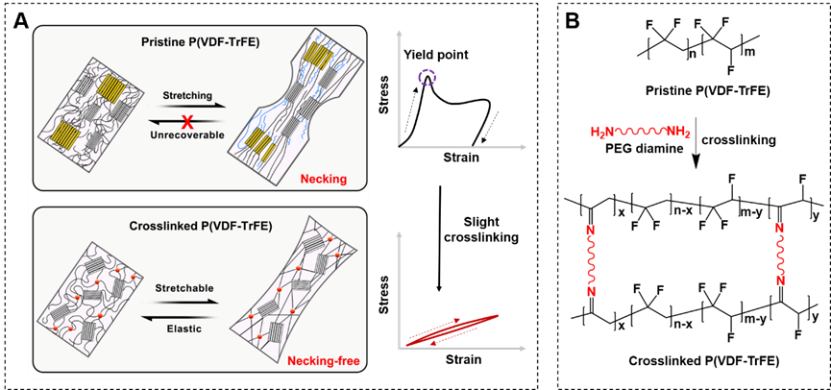On August 4, a research paper entitled "Intrinsically elastic polymer ferroelectric by precise slight cross-linking" was published in the international academic journal Science, with Gao Liang, a 2020 graduate student from USTC Nano Science and Technology Institute, as the first author. Corresponding authors Hu Benlin and Li Runwei are researchers from Ningbo Institute of Materials Technology & Engineering, CAS, and practical tutors of professional master students from the Nano Science and Technology Institute.
Ferroelectric materials are typically insulators that have enabled self-charged surfaces. In the absence of an external electric field, these charges are in a disordered state, but they will rearrange once an electric field is applied to the ferroelectric material, and their arrangement will vary with the electric field. In the meantime, ferroelectric materials have been intensively investigated for memory. For example, it memorizes the previous state of the electric field so that rearranged charges will remain unchanged even if the electric field no longer acts. It is therefore characterized by high dielectric constant, piezoelectricity, pyroelectricity and electric refrigeration, which can be used in electronic products such as computer memory, high-precision motors, ultra-sensitive sensors and sonar equipment, as well as mobile phones, tablets and other electronic devices. Rapid developments in the fields of wearable devices, flexible electronics and intelligent perception have placed increasing demands on the materials used to maintain stable performance under complex deformation. To be specific, materials used in electronic devices can be divided into conductors, semiconductors and insulating materials according to their conductivity, and the former two have been elasticized. As one of the functional materials with the most abundant properties in insulating materials, ferroelectric materials have not yet been elasticized, which greatly narrows its application in the fields of flexible and elastic electronics. It boils down to the fact that the ferroelectricity of ferroelectric materials comes from its crystalline region, but the crystal is almost inelastic. As a result, it is difficult for ferroelectric materials to give consideration to both ferroelectricity and elasticity.
The research team proposed the concept of "elastic ferroelectrics" and designed a precise "micro-crosslinking" method to establish a network structure in ferroelectric polymers. Poly (vinylidene fluoride-trifluoroethylene) (P (VDF-TrFE), 55/45 mol%) was used as the matrix material, and poly (ethylene oxide) diamine (PEG-diamine) with soft and long chains as the crosslinking material. Besides, low crosslinking density (1%~2%) was used to give linear ferropolymerization material elasticity while maintaining high crystallinity. The research shows that the cross-linked ferroelectric film mainly exhibited a β-phase crystalline structure, and the crystals were uniformly dispersed in the cross-linked network. When stressed, the network structure can uniformly disperse the external force and bear more stress, thus avoiding the damage of the crystalline region. The results also revealed that the cross-linked film maintained a constant ferroelectric response and elastic recovery even at stresses of up to 70%. The remanent polarization (about 4. 5 μC/cm2) was kept stable during the tensile process, and its mechanical and ferroelectric flipping fatigue resistance greatly improved the reliability and service life. Hence, the proposed "micro-crosslinking" is an effective method for ferroelectric elasticization, as it skillfully uses a simple chemical reaction to create a balance between between ferroelectricity and elasticity, and provides a new idea for the elasticization of ferroelectric materials.

Figure 1 Concept and synthesis strategy of elastic ferroelectricity
Paper info: https://www.science.org/doi/10.1126/science.adh2509
Gao Liang was admitted to the Nano Science and Technology Institute as a master student in 2020. In 2021, she joined the Flexible Magnetoelectric Functional Materials and Devices Team of Ningbo Institute of Materials Technology & Engineering through a joint training program. With research interests in elastic ferroelectric materials, she has been provided with support by her USTC supervisor Liu Jiangtao and practice tutor Hu Benlin.
Since its inauguration in January 2011, the Nano Science and Technology Institute has been affiliated with the School of Chemistry and Materials Science, focusing on training engineering postgraduates with a professional degree of "Materials and Chemical Engineering". In 2023, it began to run its engineering doctoral program on a pilot basis. Upholding the socialist-minded, professionally proficient school motto that associates truth with fact, educational policies, and a student-oriented & quality-based philosophy, the institute has established a cooperative training mode for postgraduates with relevant scientific research institutes, science and education integration institutes (such as Ningbo Institute of Materials Technology & Engineering, Shenzhen Institute of Advanced Technology, Suzhou Institute of Nano-Tech and Nano-Bionics, Institute of Metal Research, and Guangzhou Institute of Energy Conversion) and key enterprises. The training mode covers new materials, new energy, semiconductor, chip, double carbon and several other key areas.

Suzhou Institute for Advanced Research, University of Science and Technology of China,No.99 Ruo'shui Road( Ruo'shuiCampus), No.188 Ren'ai Road(West Campus), No.166 Ren'ai Road(East Campus), Suzhou Dushu Lake Science and Education Innovation District, Suzhou Industrial Park(SIP), Suzhou, Jiangsu, 215123, P.R.China
Email: suzhou@ustc.edu.cn
TEL:86-512-87161188
Fax:86-512-87161100
